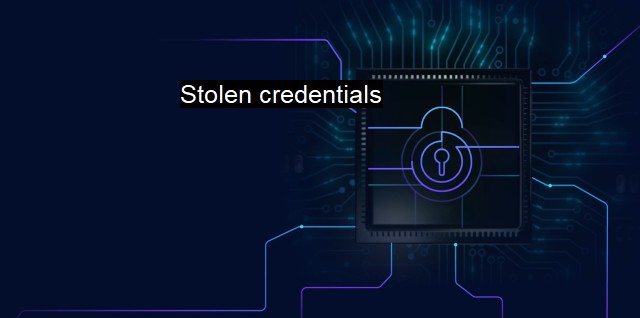What are Stolen credentials?
Stolen Credentials: The Alarming Consequences on Businesses and Cybersecurity
Stolen credentials in the world of cybersecurity pertain to any valuable, sensitive information that may be misappropriated by unauthorized individuals or parties. Typically, this involves data that provides access to various online systems such as usernames, passwords, credit card numbers, and Social Security numbers.It's like losing the keys to your house. Only, in this case, the keys enable the hacker to access an infinite number of doors with uncontrolled potential for damage. There could be a hit on one's financial resources, an overtaking of their personal identity, or an access gateway to bigger companies once the hacker penetrates a system through an employee's account.
In most cybersecurity incidents, the attackers often target credentials because of numerous reasons. Firstly, it provides them an initial access point into the network without alerting the network security team’s attention. Having convincingly legitimate access means a stealthy way for the hacker to be within the system. S/he could stay undiscovered for a considerable duration, increasing the potential of the damage caused extensively.
Secondly, having access to stolen credentials potentially provides the hackers with escalated privileges. This might mean obtaining access to hidden or sensitive areas within a network that are most likely further protected. Such privileges draw the hackers a step closer towards their final malicious intent, be it data theft, sabotage or infiltrate further into an interconnected network of systems.
One of the most significant instances of stolen credentials is the incidence of phishing. Phishing is a cybercrime where the perpetrator poses as a reputable institution and deceives individuals into providing sensitive data, like login credentials and credit card numbers. Once the hacker receives this data, it is used to access important accounts, leading to identity theft and financial loss.
This points to a computer issue, but stolen credentials, if in the wrong hands, can multiply the effect. For instance, a ransomware attack, initiated through phishing, could immediately lock all systems, preventing users from accessing their data or applications until a sizeable ransom is paid to the attacker.
To protect from the potential risks of stolen credentials, it’s crucial to adopt various layers of security measures. One popular technical solution is multi-factor authentication (MFA). This requires members to verify their identities by presenting multiple pieces of evidence, making it significantly harder for bad actors to steal credentials.
Another way to safeguard against the risk of stolen credentials is through awareness and education. Cybersecurity literacy is not exhaustive in telling users what they should do, but is just as significant in informing them of what they should also avoid doing that might explicitly put their data at risk.
Organizations can employ antivirus software to add an extra layer of protection. A powerful antivirus can detect and block phishing attacks, and scan email attachments for malware. Some advanced versions can even identify malicious websites and provide browser protection.
Stolen credentials can lead to various cybersecurity issues that hackers exploit for different illegal benefits. Given the escalating level of sophistication in malware and phishing kits, the theft of credentials is becoming easier for cyber criminals every day. Consequently, organizations and individuals must use protective measures, including antivirus and cybersecurity software, multi-factor authentication, and awareness campaigns. These tools, by increasing the security levels against cyberattacks, can ensure that sensitive data remain sheltered against unwanted stolen identity situations.

Stolen credentials FAQs
What are stolen credentials in cybersecurity?
Stolen credentials refer to login information that has been obtained by a cybercriminal without authorization. This information can include usernames, passwords, and personal identification numbers (PINs) that are used to access online accounts.How do cybercriminals steal credentials?
Cybercriminals use a variety of tactics to steal credentials, including phishing attacks, malware, and brute force attacks. These attacks are designed to trick users into sharing their login information or to steal it directly from their devices.What are the risks of stolen credentials?
The risks of stolen credentials include identity theft, financial fraud, and unauthorized access to sensitive information. If a cybercriminal gains access to your account using stolen credentials, they can use it to carry out illegal activities or steal confidential data.How can antivirus software help prevent stolen credentials?
Antivirus software can help prevent stolen credentials by detecting and blocking malware that is designed to steal login information. It can also provide warnings about phishing attempts and suspicious websites that may be trying to steal your credentials. Additionally, antivirus software can help you create stronger passwords and alert you if your login information has been compromised in a data breach.| | A | | | B | | | C | | | D | | | E | | | F | | | G | | | H | | | I | | | J | | | K | | | L | | | M | |
| | N | | | O | | | P | | | Q | | | R | | | S | | | T | | | U | | | V | | | W | | | X | | | Y | | | Z | |
| | 1 | | | 2 | | | 3 | | | 4 | | | 7 | | | 8 | | |||||||